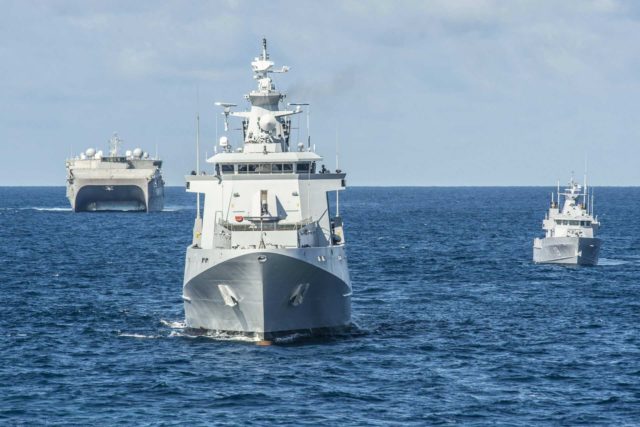
New report reveals extent of Chinese surveys in South China Sea South China Sea. (U.S. Pacific Fleet/Flickr)
This article was originally published by Radio Free Asia and is reprinted with permission.
The paths of Chinese survey vessels across the South China Sea for the past two years show a tangle of activity straddling disputed waters off the coasts of all its maritime neighbors in Southeast Asia.
A report published Tuesday by the Asia Maritime Transparency Initiative uses automatic identification system (AIS) data transmitted by Chinese vessels to reconstruct where they have been conducting surveys.
These surveys – for marine scientific research, oil and gas exploration, and military research, according to the report – stretch across the South China Sea, which China claims virtually in its entirety. The surveys have regularly dipped into the exclusive economic zones (EEZs) of neighboring countries, like Vietnam, the Philippines and Malaysia.
The report, “Chinese Surveys in the South China Sea,” is aimed at providing “a better understanding of the scope of Chinese survey activities in the South China Sea” which have become an important tool for China to assert its maritime claims.
AMTI is part of the Center for Strategic and International Studies, a Washington, D.C.-based think tank.
A map provided by AMTI shows very busy patterns of Chinese survey activities in the South China Sea during 2020-2021. The report finds that the surveys have become a standard response by China to Southeast Asian offshore oil and gas activity in the South China Sea.
On numerous occasions, when a neighboring country began a new oil and gas activity in its EEZ, China responded by sending its own survey ships escorted by the China Coast Guard and maritime militia to the same location.
“The report highlights the scale and hypocrisy of China’s survey activities,” said Greg Poling, the AMTI director.
“Beijing conducts dozens of operations in its neighbors’ EEZs every year which, if civilian in nature, are illegal or, if military, are exactly what China claims other countries are not allowed to do in its own EEZ,” he said.
Surveying for marine scientific research or oil and gas exploration in another country’s EEZ is illegal under international law. Surveys done for purely military research purpose are not illegal but “run counter to China’s stated opposition to foreign military surveys within the EEZ,” the report says.
China promulgated a Law on the Exclusive Economic Zone and the Continental Shelf in 1998 after it had ratified the United Nations Convention on the Law of the Sea (UNCLOS) in 1996.
According to the Chinese EEZ Law, any maritime or scientific research in the EEZ and the continental shelf of China would be subject to approval by the Chinese authorities. This is also the usual practice under UNCLOS, though Chinese survey vessels often operate in other countries’ EEZs without permission.
When it comes to military activities, while most of the signatory states of UNCLOS support the view that military operations, exercises and activities have always been regarded as internationally lawful uses of the sea, including within the EEZs of other states, China continues to assert its right to regulate foreign military activities in its claimed EEZ.
A study by the U.S.-China Economic and Security Review Commission, a congressional advisory body, found that “China’s position is based largely on its view that it has the right to prevent any activity that directly or indirectly threatens its security or economic interests.”
Lack of trust
A survey report entitled The State of Southeast Asia 2022, published by the ISEAS – Yusof Ishak Institute in Singapore, found that 41.7 percent of respondents view China as a “revisionist power” that “intends to turn Southeast Asia into its sphere of influence.”
It says that 58.1 percent of the respondents – made up of policymakers, academics, researchers, businesspeople, media personnel, and civil society activists from 10 Southeast Asian countries – expressed little or no confidence in China to do the right thing to contribute to global peace, security, prosperity, and governance.
“This follows China’s military build-ups in the South China Sea in recent years and the intrusions into Southeast Asian claimant states’ EEZ, with the ambitious goal of militarily dominating the South China Sea,” the ISEAS – Yusof Ishak’s report said.
The new AMTI report hints at a similar goal through China’s use of survey vessels, ostensibly intended for research. “The immediate impact and apparent intention of these (maritime) surveys is to demonstrate Chinese control over waters it claims as its own.”
But there’s also a practical benefit. “Aside from their symbolic goals, these surveys also produce data on seabed conditions that hold value for both civilian and military purposes,” the AMTI report said.
“China’s pursuit of civil-military integration makes it likely that data obtained by Chinese survey vessels is shared among scientific, military, and commercial entities.”
China operates by far the largest fleet of government research vessels in the region.
According to the database of the International Maritime Organization, there are 64 registered Chinese survey vessels built in or after 1990, surpassing the U.S.’s 44 and Japan’s 23.
During 2019-2020, China deployed 25 government vessels in waters beyond its recognized national jurisdiction in the Indo-Pacific, compared to 10 from the U.S., according to AMTI.
The Chinese government has yet to say anything about the AMTI report, but Beijing has always maintained that its survey efforts are lawful operations in waters under its jurisdiction.
Experts say the surveys tend to respect the notional nine-dash line which roughly outlines China’s own territorial claim over virtually the entire South China Sea, and which was rejected by a U.N. tribunal in 2016.




